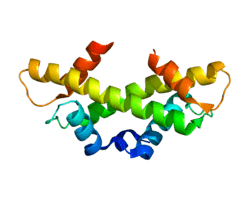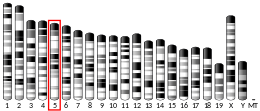CENPA
Centromere protein A, also known as CENPA, is a protein which in humans is encoded by the CENPA gene.[5]
Function
Centromeres are the chromosomal domains that specify the mitotic behavior of chromosomes. The CENPA gene encodes a centromere protein which contains a histone H3 related histone fold domain that is required for targeting to the centromere. CENPA is proposed to be a component of a modified nucleosome or nucleosome-like structure in which it replaces 1 or both copies of conventional histone H3 in the (H3-H4)2 tetrameric core of the nucleosome particle. Alternative splicing results in multiple transcript variants encoding distinct isoforms.[5]
In higher eukaryotes, the recruitment of CENP-A nucleosomes to existing centromeres is an epigenetic process, independent of the underlying DNA sequence. In S. pombe, de novo recruitment of the CENP-A to the centromere is believed to be controlled by "centromeric" heterochromatin surrounding the centromere, and by an RNAi mechanism. The RNAi is cut to form siRNA; this complexes with the protein Chp1, which then binds the centromeric heterochromatin. This helps recruit other proteins, ultimately resulting in a protein complex that forms cohesin between two sister chromatids at the centromeric heterochromatin. This cohesin is believed to be essential in replacing the centromere H3 with CENP-A. CENP-A is one of the epigenetic changes that is believed to distinguish centromeric DNA from other DNA.[6] Once the CENP-A has been added, the centromere becomes self-propagating, and the surrounding heterochromatin/RNAi mechanism is no longer necessary.[7]
References
- GRCh38: Ensembl release 89: ENSG00000115163 - Ensembl, May 2017
- GRCm38: Ensembl release 89: ENSMUSG00000029177 - Ensembl, May 2017
- "Human PubMed Reference:". National Center for Biotechnology Information, U.S. National Library of Medicine.
- "Mouse PubMed Reference:". National Center for Biotechnology Information, U.S. National Library of Medicine.
- EntrezGene 1058
- Chueh AC, Wong LH, Wong N, Choo KH (January 2005). "Variable and hierarchical size distribution of L1-retroelement-enriched CENP-A clusters within a functional human neocentromere". Hum. Mol. Genet. 14 (1): 85–93. doi:10.1093/hmg/ddi008. PMID 15537667.
- Folco HD, Pidoux AL, Urano T, Allshire RC (January 2008). "Heterochromatin and RNAi are required to establish CENP-A chromatin at centromeres". Science. 319 (5859): 94–7. doi:10.1126/science.1150944. PMC 2586718. PMID 18174443.
External links
- Human CENPA genome location and CENPA gene details page in the UCSC Genome Browser.
Further reading
- Palmer DK, O'Day K, Trong HL, Charbonneau H, Margolis RL (1991). "Purification of the centromere-specific protein CENP-A and demonstration that it is a distinctive histone". Proc. Natl. Acad. Sci. U.S.A. 88 (9): 3734–8. doi:10.1073/pnas.88.9.3734. PMC 51527. PMID 2023923.
- Sullivan KF, Hechenberger M, Masri K (1994). "Human CENP-A contains a histone H3 related histone fold domain that is required for targeting to the centromere". J. Cell Biol. 127 (3): 581–92. doi:10.1083/jcb.127.3.581. PMC 2120219. PMID 7962047.
- Shelby RD, Vafa O, Sullivan KF (1997). "Assembly of CENP-A into centromeric chromatin requires a cooperative array of nucleosomal DNA contact sites". J. Cell Biol. 136 (3): 501–13. doi:10.1083/jcb.136.3.501. PMC 2134286. PMID 9024683.
- Valdivia MM, Figueroa J, Iglesias C, Ortíz M (1998). "A novel centromere monospecific serum to a human autoepitope on the histone H3-like protein CENP-A". FEBS Lett. 422 (1): 5–9. doi:10.1016/S0014-5793(97)01583-4. PMID 9475158.
- Fowler KJ, Newson AJ, MacDonald AC, Kalitsis P, Lyu MS, Kozak CA, Choo KH (1998). "Chromosomal localization of mouse Cenpa gene". Cytogenet. Cell Genet. 79 (3–4): 298–301. doi:10.1159/000134748. PMID 9605877.
- Muro Y, Azuma N, Onouchi H, Kunimatsu M, Tomita Y, Sasaki M, Sugimoto K (2000). "Autoepitopes on autoantigen centromere protein-A (CENP-A) are restricted to the N-terminal region, which has no homology with histone H3". Clin. Exp. Immunol. 120 (1): 218–23. doi:10.1046/j.1365-2249.2000.01189.x. PMC 1905620. PMID 10759786.
- Lomonte P, Sullivan KF, Everett RD (2001). "Degradation of nucleosome-associated centromeric histone H3-like protein CENP-A induced by herpes simplex virus type 1 protein ICP0". J. Biol. Chem. 276 (8): 5829–35. doi:10.1074/jbc.M008547200. PMID 11053442.
- Uren AG, Wong L, Pakusch M, Fowler KJ, Burrows FJ, Vaux DL, Choo KH (2001). "Survivin and the inner centromere protein INCENP show similar cell-cycle localization and gene knockout phenotype". Curr. Biol. 10 (21): 1319–28. doi:10.1016/S0960-9822(00)00769-7. PMID 11084331.
- Zeitlin SG, Shelby RD, Sullivan KF (2002). "CENP-A is phosphorylated by Aurora B kinase and plays an unexpected role in completion of cytokinesis". J. Cell Biol. 155 (7): 1147–57. doi:10.1083/jcb.200108125. PMC 2199334. PMID 11756469.
- Ando S, Yang H, Nozaki N, Okazaki T, Yoda K (2002). "CENP-A, -B, and -C chromatin complex that contains the I-type alpha-satellite array constitutes the prekinetochore in HeLa cells". Mol. Cell. Biol. 22 (7): 2229–41. doi:10.1128/MCB.22.7.2229-2241.2002. PMC 133672. PMID 11884609.
- Saxena A, Saffery R, Wong LH, Kalitsis P, Choo KH (2002). "Centromere proteins Cenpa, Cenpb, and Bub3 interact with poly(ADP-ribose) polymerase-1 protein and are poly(ADP-ribosyl)ated". J. Biol. Chem. 277 (30): 26921–6. doi:10.1074/jbc.M200620200. PMID 12011073.
- Figueroa J, Pendón C, Valdivia MM (2003). "Molecular cloning and sequence analysis of hamster CENP-A cDNA". BMC Genomics. 3: 11. doi:10.1186/1471-2164-3-11. PMC 113255. PMID 12019018.
- Saxena A, Wong LH, Kalitsis P, Earle E, Shaffer LG, Choo KH (2003). "Poly(ADP-ribose) polymerase 2 localizes to mammalian active centromeres and interacts with PARP-1, Cenpa, Cenpb and Bub3, but not Cenpc". Hum. Mol. Genet. 11 (19): 2319–29. doi:10.1093/hmg/11.19.2319. PMID 12217960.
- Tomonaga T, Matsushita K, Yamaguchi S, Oohashi T, Shimada H, Ochiai T, Yoda K, Nomura F (2003). "Overexpression and mistargeting of centromere protein-A in human primary colorectal cancer". Cancer Res. 63 (13): 3511–6. PMID 12839935.
- Kunitoku N, Sasayama T, Marumoto T, Zhang D, Honda S, Kobayashi O, Hatakeyama K, Ushio Y, Saya H, Hirota T (2004). "CENP-A phosphorylation by Aurora-A in prophase is required for enrichment of Aurora-B at inner centromeres and for kinetochore function". Dev. Cell. 5 (6): 853–64. doi:10.1016/S1534-5807(03)00364-2. PMID 14667408.
- Obuse C, Yang H, Nozaki N, Goto S, Okazaki T, Yoda K (2004). "Proteomics analysis of the centromere complex from HeLa interphase cells: UV-damaged DNA binding protein 1 (DDB-1) is a component of the CEN-complex, while BMI-1 is transiently co-localized with the centromeric region in interphase". Genes Cells. 9 (2): 105–20. doi:10.1111/j.1365-2443.2004.00705.x. PMID 15009096.
- Yasuda S, Oceguera-Yanez F, Kato T, Okamoto M, Yonemura S, Terada Y, Ishizaki T, Narumiya S (2004). "Cdc42 and mDia3 regulate microtubule attachment to kinetochores". Nature. 428 (6984): 767–71. doi:10.1038/nature02452. PMID 15085137.
- Black BE, Foltz DR, Chakravarthy S, Luger K, Woods VL Jr, Cleveland DW (2004). "Structural determinants for generating centromeric chromatin". Nature. 430 (6999): 578–82. doi:10.1038/nature02766. PMID 15282608.
- Sullivan BA, Karpen GH (2004). "Centromeric chromatin exhibits a histone modification pattern that is distinct from both euchromatin and heterochromatin". Nat. Struct. Mol. Biol. 11 (11): 1076–83. doi:10.1038/nsmb845. PMC 1283111. PMID 15475964.
- Nikolina S, Basset EA, Robers DJ, Black BE (2010). "The structure of (CENP-A?H4)2 reveals physical features that mark centromeres". Nature. 467 (7313): 347–351. doi:10.1038/nature09323. PMC 2946842. PMID 20739937.




